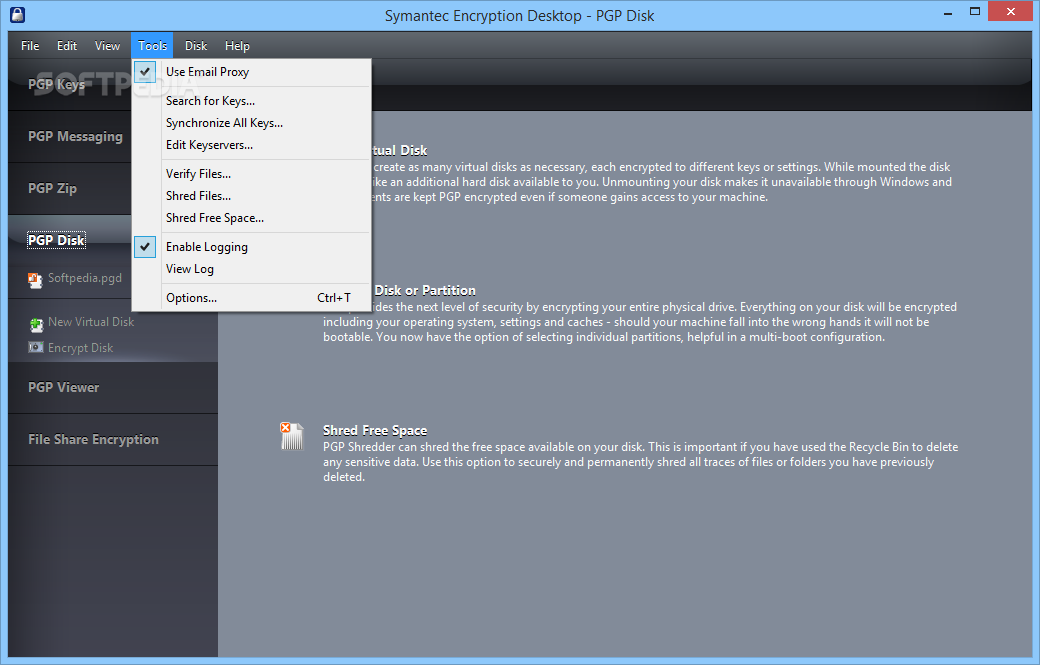
- Symantec encryption desktop support how to#
- Symantec encryption desktop support install#
- Symantec encryption desktop support drivers#
- Symantec encryption desktop support driver#
However, by using WinObj from Sysinternals, even with full administrative privileges, we were immediately receiving an access denied error. To start with, by using DeviceTree by OSR, we could see that PGPwded.sys exposed a device object named PGPwdef.Īccording to its security attributes, all users should be able to access that object.
Symantec encryption desktop support drivers#
While we were going through the exposed named device objects by the kernel drivers installed, we noticed something interesting.
Symantec encryption desktop support driver#
Module: eedDiskEncryptionDriver.sys v11.1.3īefore discussing the two interesting input/output control requests (IOCTLs) and some associated code snippets, we need to focus on the practice that ultimately allows any user to take advantage of the disk read/write capabilities of the kernel driver under examination.Symantec Endpoint Encryption version v11.1.3 MP1 and earlier.Symantec Encryption Desktop suite version 10.4.1 MP2HF1 and earlier.We will then discuss how access control to file and directory objects is enforced by NTFS, attack methods, problems, possible solutions to complete the exploit, and their limitations.īut first, here is a video demonstration of the vulnerability being exploited in the latest Windows 10 v1709 64-bit.

We will provide a short overview of the discovery and nature of the vulnerability.

Since many of the exploitation techniques that we come across rely on memory corruption, we thought that demonstrating exploitation of this type of flaw would be interesting and informative. They also allow the attacker to execute code in the context of the built-in SYSTEM user account, without requiring a reboot. These vulnerabilities allow an attacker to attain arbitrary hard disk read and write access at sector level, and subsequently infect the target and gain low level persistence (MBR/VBR). In this article we discuss various approaches to exploiting a vulnerability in a kernel driver, PGPwded.sys, which is part of Symantec Encryption Desktop. For more information, see the following SYMC Advisory: While there is no plan to produce a patch for Symantec Encryption Desktop, the Symantec Security and Development teams have recommendations to mitigate the risks involved. Symantec has produced a patch for Symantec Endpoint Encryption as of version 11.3.0 but not for Symantec Encryption Desktop. This vulnerability affected both Symantec Endpoint Encryption and Symantec Encryption Desktop. We will continue to work with Symantec to help them to produce an effective patch. Consequently, we are at the point of publishing the findings publicly. We have been working with Symantec to try and help them to fix this since our initial private disclosure in July 2017 (full timeline at the end of this article), however no patch has yet been released. Thank you.Note: These vulnerabilities remain unpatched at the point of publication.
Symantec encryption desktop support how to#
It also gives me the option of a WDRT token, but I do not know how to find that.Īny assistance would be greatly appreciated. Then when I select ok, it just takes me in a loop back to the "Checking Media" screen and back to the boot failed screen, and the only way out of it is to turn off the computer.Ĭan anything be done to regain access to the computer? It is a new computer, so wiping out the hard drive is an option. I then tried the windows password that I set up, and it took me to a Boot Manager with a "Boot Option Menu" that listed "EFI PXE Network." When I selected that, I got a screen that said "Checking Media" and then a blue box that read "EFI Network 0 for IPv4 (1C-39-47-35-19-5A) boot failed. I again entered the passphrase that I created, and it was not accepted. When my computer rebooted, I was prompted with a Symantec Encryption Desktop screen that asked my for my passphrase. So I closed the program and uninstalled Symantec Endpoint Encryption and restarted my computer.

When I tried to encrypt my entire drive, my passphrase was not accepted.
Symantec encryption desktop support install#
I started to install the trial version of Symantec Endpoint Encryption on Windows 10 Home.


 0 kommentar(er)
0 kommentar(er)
